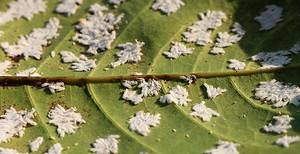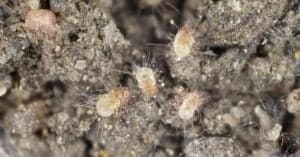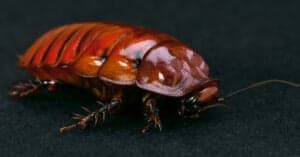Gardeners have been engaged in a long-time battle with aphids, who swoop in and suddenly wreak havoc on their tender tendrils and precious petals in no time. But, some creatures are actually quite fond of the little buggers for their habit of depositing large amounts of excess sugar called honeydew.
Sugar-loving ants go so far as to become aphid-herders and will care for the aphids over time. They carry them plant-to-plant and milk them for their sweet honeydew by stroking their abdomens. In this mutually beneficial exchange, they provide the aphids protection from predators and parasites while gaining a consistent supply of sweet nourishment. Some even take aphids to their nests for the winter months, protecting them until spring comes. So, what do aphids eat? Where do they get all this excess sugar?
What Do Aphids Eat?
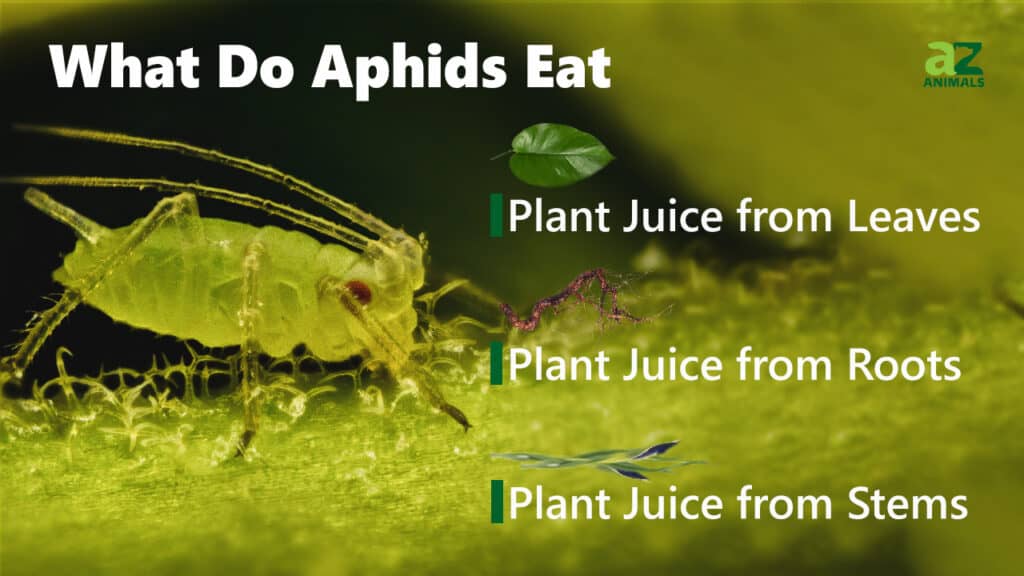
Aphids eat a diet that consists entirely of plant sap. They are herbivores who obtain the sap through plants’ phloem vessels.
Within the family Aphididae, there are about 4,000 aphid species. Roughly 400 of them are found on food and fiber crops. Aphids are especially drawn to young plants and budding flowers whose saps are ripe for sucking. Some species are fond of specific plants such as roses, while others feed on hundreds of different plant species. Plant sap is full of sugars which the bacteria Buchnera aphidicola break down into amino acids that the aphids need to survive. The relationship between aphids and this bacteria is an example of endosymbiosis, in which each organism is required for the survival of the other.
Aphids feed on the sap of plants through the plant’s phloem vessels. Phloem is a type of transport tissue that moves sugars throughout the plant to where they’re needed. This is the main sap aphids are after, but they also feed on xylem sap. Xylem is another type of transport tissue that delivers water and some nutrients from roots to stems and leaves. It’s more dilute than phloem sap. Its sugar and amino acid concentrations are 1% of those in phloem.
How Do Aphids Eat?
Aphids find new host plants by seeking with the senses of both sight and smell. They use their antennae to decide if a plant smells appetizing and if it does, they land on it and begin to probe its surface. These insects use a syringe-like appendage called a stylus to pierce the plant and suck its sap. First, they insert the stylus and secrete some saliva during the first sap sampling. Next, they taste the xylem sap of the plant. Finally, they taste the phloem sap and consume it in large quantities.
Once they puncture a phloem vessel, the high pressure the sap’s under as it flows through the plant forces the sap into the aphids’ food canal. Aphids acquire phloem sap passively, but xylem sap requires active sucking since it’s under negative pressure. They accomplish this sucking through a pump mechanism in their head that’s designed for the purpose. Plant sap is largely sugar and water, so it’s low in protein, and aphids have to ingest lots of it to meet their nutritional requirements. Lucky for those ants, the aphids’ bodies don’t use all the sugar they consume, and the excess gets excreted as sweet, sweet honeydew.
How Do Aphids’ Diet Affect Plants?
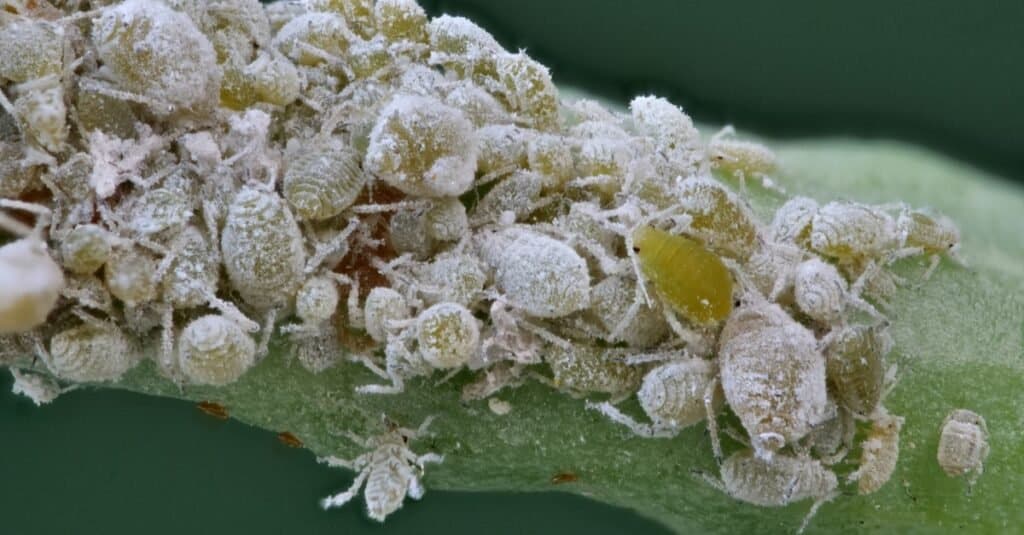
A large infestation of aphids weakens plants.
©Holger Kirk/Shutterstock.com
Sap-sucking in itself isn’t necessarily harmful to host plants, but a large infestation of these insects is likely to weaken plants. Healthy, well-established plants will likely wilt and turn yellow in response, but they won’t usually be seriously harmed. The cosmetic effect is an irritation to gardeners and plant cultivators of all stripes, but aphids are also capable of causing some serious damage.
Have you ever seen trails of a glistening, sticky substance on your plants? You were probably looking at honeydew left behind by aphids. Honeydew’s not necessarily damaging to plants in itself, but it causes problems with some plants infested with large aphids populations. Sooty mold can grow quickly on honeydew and grow to cover a plant’s leaves and branches. As a fungus, the sooty mold thrives on sugary substances like honeydew and can quickly proliferate. A large amount of sooty mold can block the plants’ sunlight and reduce its capacity for photosynthesis.
Aphids can also spread diseases quickly among plants. If an aphid feeds on an infected plant, it becomes a carrier and is likely to infect the next plant it goes to feed on. Aphids reproduce quickly, so it can be very hard to stop once an infestation starts. And aphids do reproduce quickly– female aphids are parthenogenetic, able to reproduce without mating. They don’t even waste time waiting for eggs to hatch, and they give birth to live young. In some cases, the nymphs (the young) they give birth to are already pregnant themselves!
What Eats Aphids?
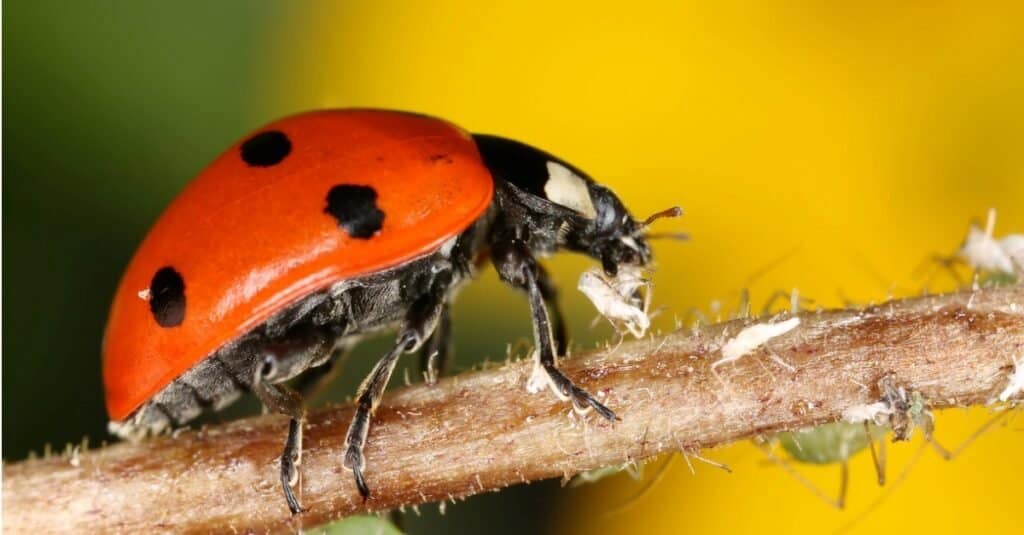
Aphids are eaten by birds and other insects.
©iStock.com/Henrik_L
A wide array of birds and insects consider aphids a sweet treat. Aphid lovers include American goldfinches, vesper sparrows, ladybugs, lacewings, hoverfly larvae, parasitic wasps, damsel bugs, and lacewings among others. Bacteria, viruses, and fungi also threaten aphids.
With so many predators, aphids have developed a protective response to avoid turning into someone’s tasty treat. They have a pair of tubular structures called cornicles on their hind legs. They look like tiny tailpipes and release a waxy fluid in response to threat. The mouths of predators go gummy with the sticky substance, and it’s believed to trap parasites before they can infect the aphids. These cornicles also release pheromones as an alarm to warn other aphids of danger. However, the ladybug has outsmarted them in this defense and learned to follow the chemical signals right to their source for a snack.
The photo featured at the top of this post is © Radu Bercan/Shutterstock.com
Thank you for reading! Have some feedback for us? Contact the AZ Animals editorial team.




